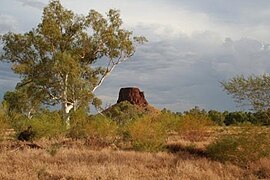Pannawonica, Western Australia: Difference between revisions
Corrected grammar in population makeup sentence |
m →External links: attach links to descriptions |
||
| Line 42: | Line 42: | ||
== External links == |
== External links == |
||
* |
*[http://www.roberiver.com Robe River Iron] |
||
* |
*[http://www.pilbarairon.com Pilbara Iron] |
||
* |
*[http://www.riotinto.com Rio Tinto] |
||
* |
*[http://www.landgate.wa.gov.au Landgate] |
||
* |
*[http://www.police.wa.gov.au WA Police] |
||
[[Category:Mining towns in Western Australia]] |
[[Category:Mining towns in Western Australia]] |
||
Revision as of 06:53, 12 May 2008
| Pannawonica Western Australia | |||||||||
|---|---|---|---|---|---|---|---|---|---|
 Pannawonica Hill | |||||||||
| Population | 800 | ||||||||
| Established | 1970 | ||||||||
| Postcode(s) | 6716 | ||||||||
| Elevation | 200 m (656 ft) | ||||||||
| Location | |||||||||
| LGA(s) | Shire of Ashburton | ||||||||
| State electorate(s) | Central Kimberley-Pilbara | ||||||||
| Federal division(s) | Kalgoorlie | ||||||||
| |||||||||
The town of Pannawonica is located in the Pilbara region of Western Australia, near the Robe River.
Pannawonica’s weather is recorded by the Australian Bureau of Meteorology station number 005069, which was opened in 1971. Between 1971 and 2005, the mean maximum temperature at Pannawonica ranged from 26.7°C in July to 40.9°C in January. Pannawonica experiences a wet season that can stretch from December to March, and cyclonic storm events.
Pannawonica was built in 1970 by Robe River Iron Associates (previously known as Cliffs Robe River Iron Associates), and was gazetted a town site in 1972.
It is believed that the township’s name has an Aboriginal origin and was derived from the nearby Pannawonica Hill, a name first recorded by a surveyor in 1885. Pannawonica is said to mean "the hill that came from the sea". The story is that two local Aboriginal tribes were arguing over the ownership of the hill which was located by the sea. The sea spirit decided to resolve the dispute by moving the hill inland. As the hill was dragged over the land it left a deep indentation which became the Robe River.
Pannawonica is one of the many iron ore mining towns built within the Pilbara to house workers who operate nearby open cut iron ore mines. It is a 'closed town'. This does not mean that you can not visit. The term 'closed town' is used by mining companies to describe towns where there are limited facilities for visitors, and the accommodation is reserved for mining company staff. Visitor accommodation is available at the Pannawonica tavern.
Pannawonica is home to more than 800 people, comprising Robe and Pilbara Iron employee families, staff on fly-in fly-out (‘fifo’) roster from Perth, and those involved in support services.
The town’s facilities include a post office, supermarket, milk-bar, tavern, a public swimming pool, sports fields, police station, petrol station, and a free drive-in cinema, that shows movies on Friday and Sunday nights. The police officers based at Pannawonica supervise an area of approximately 33,800 square kilometres.
The Pannawonica Robe River Rodeo, which occurs every September, attracts an average of 1500 people from all over Australia. Funds raised are distributed to many organisations including the Royal Flying Doctor Service, local school and other volunteer based groups.
The Pannawonica residents work at the nearby Mesa J iron ore body. Mesa is a Spanish word that means ‘table’, which describes the appearance of the flat topped iron ore plateaus, which stand above the surrounding ground.
The Mesa J operation produces two pisolite (spheroidal crystalline particles) products called Robe River Fines and Robe River Lump. The blasted high grade ore is hauled directly to a train load-out. The sub-grade ore is washed and screened prior to loading onto the trains that can stretch for three kilometres. Mesa J transports about 32 million tonnes of iron ore per year via the company’s private 200 kilometre long rail line to a processing and port facilities at Cape Lambert.
